Chapter: 11th Geography : Chapter 7 : The Biosphere
Endangered species
Endangered
species
Rare, endangered or threatened plants
and animals are elements of our natural heritage that are declining rapidly. If
we cherish these species, like we do other rare and beautiful objects, these
living organisms become treasures of the highest magnitude.
The International Union for the Conservation of Nature (IUCN) has identified and classified species based on the nature of their depleting numbers. The IUCN’s Red List of Threatened Species, identified in 1964, is the world’s most important inventory of the global conservation status of biological species.
Species are classified by the IUCN
Red List into nine groups specified through criteria such as rate of decline,
population size, area of geographic distribution, and degree of population and
distribution fragmentation (Figure 7.11).

• Extinct (EX) – The species has
disappeared and no known individuals remaining
•
Extinct in the wild (EW) – Known only to survive in captivity, or as a
naturalized population outside its historic range
•
Critically Endangered (CR) – Species that have drastically dwindled and
are at extremely high risk of extinction in the wild
•
Endangered (EN) – High risk of extinction in the wild
•
Vulnerable (VU) – High risk of endangerment in the wild
•
Near threatened (nt) – Likely to become endangered in the near future.
•
Least concern (lc) – Lowest risk widespread and abundant
•
Conservation dependent (cd) – This group has now merged with near
threatened.
•
Data deficient (dd) – Not enough data to assess the risk of extinction
of the species.
•
Not evaluated (ne) – Species not yet been evaluated against the
criteria.
In the context of the IUCN Red List,
‘threatened’ embraces the three categories of Critically Endangered,
Endangered, and Vulnerable.
According to the IUCN those species
that have dwindled drastically are called as Critically Endangered and are
included as Red List. Species that have disappeared are called as extinct
species. In the Red List of 2012 that was released on 19 July 2012 at Rio+20
Earth Summit 19,817 species were threatened with extinction.
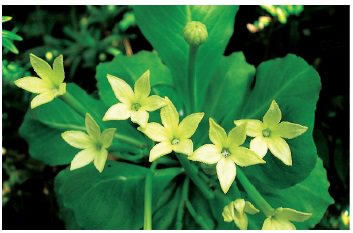
A Hawaiian plant species called Alula
locally referred to as cabbage on a stick has moved from Critically Endangered
to Extinct in the Wild. It is one of the 38 Red Listed Hawaiian plant species
with less than five wild individuals remaining. It used to grow on the windy
sea cliffs of Kauai. Alula was destroyed by hurricanes Iwa and Inki in 1982 and
1992 leaving only less than 10 plants alive.
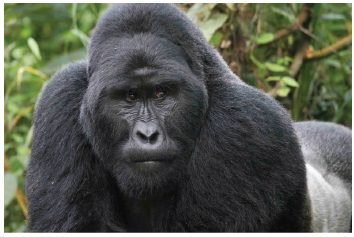
The majority of the great ape species
are now Critically Endangered. The Eastern Gorilla the largest living primate
is endemic to the Eastern Democratic Republic of Congo, south western Uganda
and Rwanda. This species which was listed as Endangered has moved to Critically
Endangered in 2016 due to an ongoing population decline. This decline is due to
illegal hunting and destruction of forests for agriculture. If this trend
continues, around 93% of Eastern Gorillas will be eliminated by 2054.
The Pygmy Hog: It is the smallest and rarest wild
pig on earth and it is a Critically Endangered species previously spread across Bangladesh,
Bhutan, India and Nepal. but now only found in Assam, India. In 1995, the Pygmy
Hog Conservation Programme was started by Goutam Narayan of Ecosystems-India,
with the help of the Assam government and now their numbers have increased to
about 150.
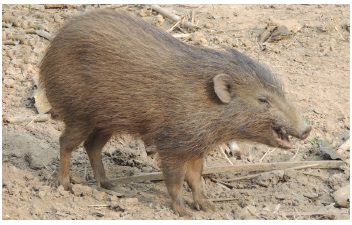
There are many other critically
endangered species in India and some of them are listed below
Critically Endangered species in India 2016
Arthropoda
•
Rameshwaram parachute spider
•
Peacock tarantula
Birds
•
White-bellied heron
•
Great Indian bustard
•
Forest owlet
•
Spoon-billed sandpiper
•
Siberian crane
•
Indian vulture
•
Himalayan quail
•
Pink-headed duck
Fish
•
Wayanad mahseer
•
Pondicherry shark
•
Ganges shark
•
Pookode Lake barb
•
Common sawfish
Insects
•
Pygmy Hog Sucking Louse
Reptiles
and amphibians
•
Madras spotted skink
•
Gharial
•
Toad-skinned frog
•
Charles Darwin’s frog
•
White-spotted bush frog
•
Munnar bush frog
•
Ponmudi bush frog
•
Anaimalai flying frog
Mammals
•
Asiatic cheetah
•
Namdapha flying squirrel
•
Himalayan wolf
•
Andaman shrew
•
Nicobar shrew
•
Northern Sumatran rhinoceros
•
Chinese pangolin
•
Pygmy hog
•
Indian Javan rhinoceros
•
Malabar large-spotted civet
The Recent Red List (2017)
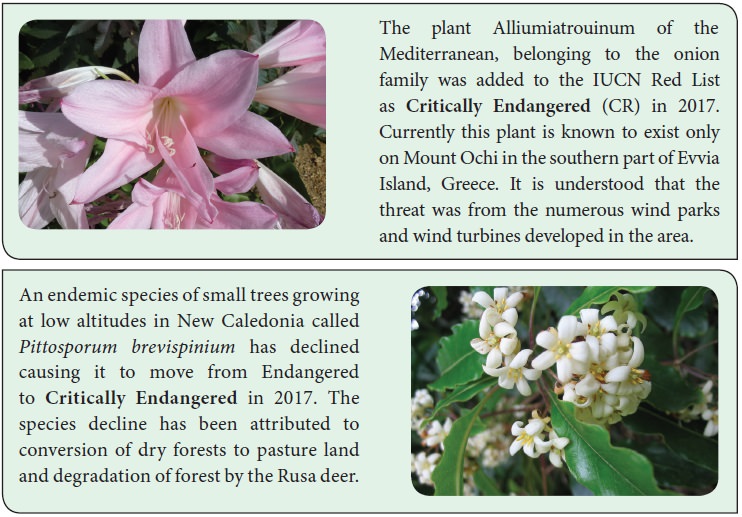
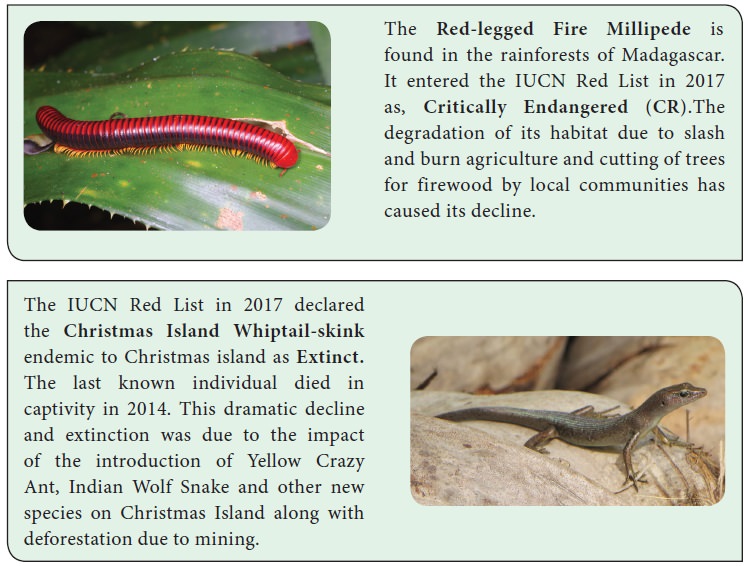

The plant Alliumiatrouinum of the
Mediterranean, belonging to the onion family was added to the IUCN Red List as Critically
Endangered (CR) in 2017.
Currently this plant is known to exist only on Mount Ochi in the southern part
of Evvia Island, Greece. It is understood that the threat was from the numerous
wind parks and wind turbines developed in the area.
An endemic species of small trees
growing at low altitudes in New Caledonia called Pittosporum brevispinium has declined causing it to move from Endangered to
Critically Endangered in 2017. The species decline has been attributed
to conversion of dry forests to pasture land and degradation of forest by the
Rusa deer.
The Red-legged Fire Millipede is found in the rainforests of Madagascar. It entered the IUCN Red List in 2017 as, Critically Endangered (CR).The degradation of its habitat due to slash and burn agriculture and cutting of trees for firewood by local communities has caused its decline.
The IUCN Red List in 2017 declared
the Christmas Island Whiptail-skink endemic to Christmas island as Extinct. The last known individual died in
captivity in 2014. This dramatic decline and extinction was due to the impact
of the introduction of Yellow Crazy Ant, Indian Wolf Snake and other new
species on Christmas Island along with deforestation due to mining.
The status of the Rodrigues Flying Fox moved from Critically Endangered to Endangered in 2017. This was due to a number of conservation measures taken, such as, captive breeding programme involving 46 zoos around the world, restoration of natural habitat, watershed protection, and awareness rising through education programmes. Its population has increased from 4,000 in 2003 to about 20,000 individuals in 2016. The future survival of this species will depend on continued conservation efforts.
Causes of Extinction of Species
Extinction is defined as the
permanent disappearance of an organism from the face of the earth. In other words,
all members of a species have died. This means a loss of biodiversity.
Extinction of species may take place (Figure 7.12) due to a variety of causes
as given below:
•
Sudden and rapid changes of environmental conditions
•
The sudden outbreak of disease and pest infections.
•
Some sudden events like forest fires, volcanic eruption etc.
•
Direct hunting and persecution of species leading to ‘selective mass
extinction.
•
Ecological substitution by other species of large carnivorous animals
which compete for the same food resources.
•
Climatic change accelerates the competition between large mammals for
shelter and food.
•
Extinction of weak species during the course of competition with more
powerful and stronger species.
•
Man-induced environmental changes also cause species extinctions.

Between 1600 and 1900 it is estimated
that one species went extinct every four years. In modern times, the rate is
soaring. The graph below (Figure 7.12.) shows how the rate of extinction of
species has increased over the past 50 years. This could be attributed to the
rapid increase in population during the same period of time.
According to IUCN the rate of
extinction of mammals and birds had started much earlier by 1700 itself at a
much faster rate as shown in the graph below (Figure 7.13).
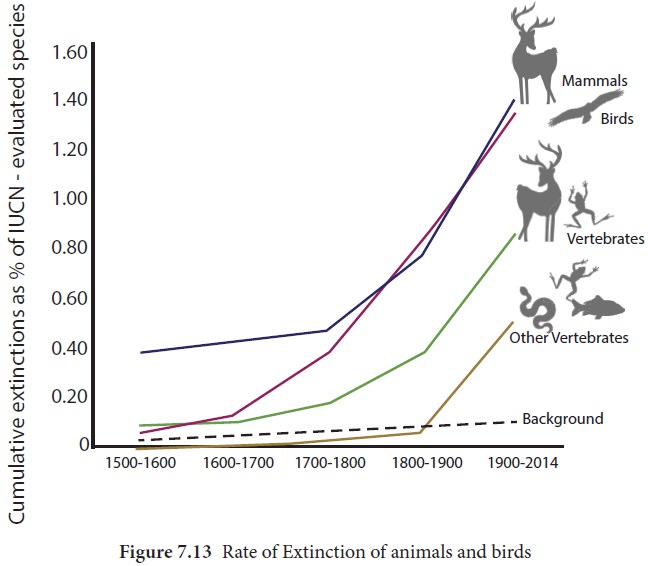
Major Threats to Biodiversity
The following are some of the major
threats to biodiversity:
a.
Habitat destruction and degradation
b.
Invasive alien species-these can destroy native species Example, lantana
Camera plant in India.
c.
Climate Change- Example, bleaching and loss of coral reefs due to global
warming
d.
Pollution of air, water and soil – Pollution can alter the growth and
life of organisms in a great way.
e.
Over exploitation of one resource – Over exploitation through Hunting or
Poaching, Deforestation etc., can influence the life of all the interdependent
species.
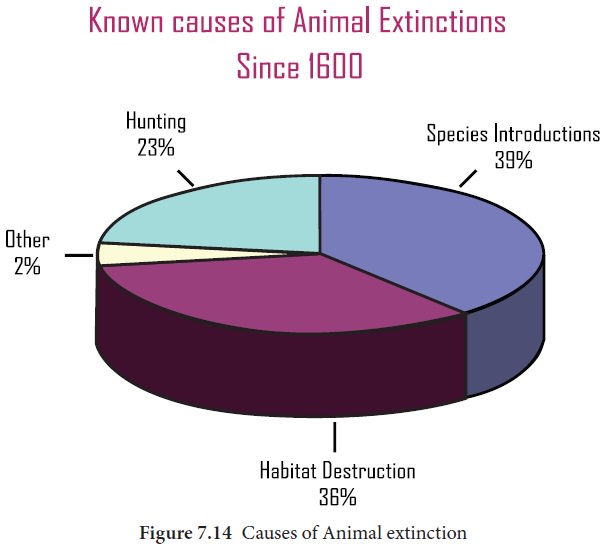
Despite rapid efforts in protecting terrestrial
and marine habitats, world’s diversity of species is still dwindling. Since the
1960’s over 100,000 ‘protected areas’ have been established. This represents
11,265,408 sq.km of land and 1,609,344 sq.km of ocean. Yet, terrestrial and
marine species have declined over the same period. This suggests that the
common conservation strategy of protecting areas of land and sea is inadequate.
Related Topics